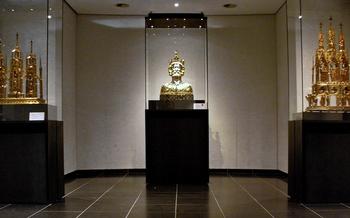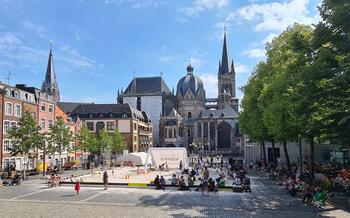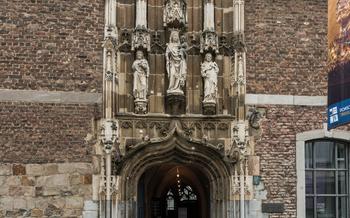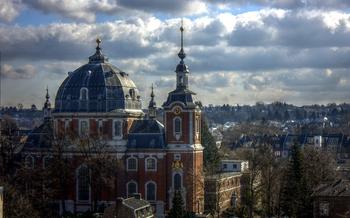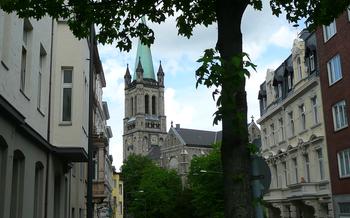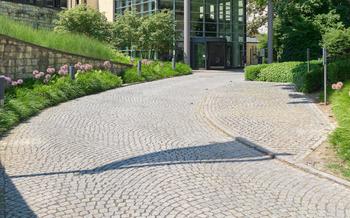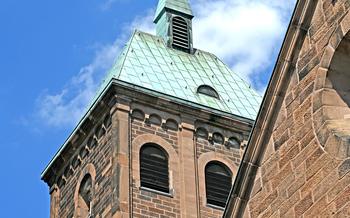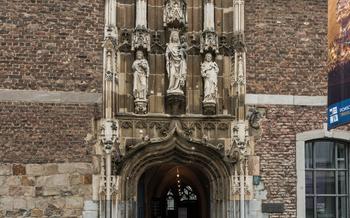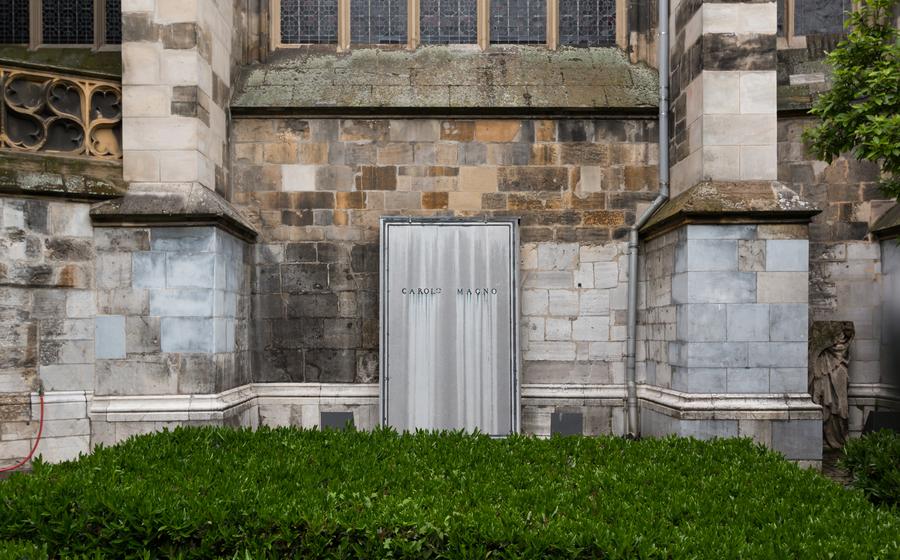
Aachen Cathedral (Aachener Dom)
- Aachen Cathedral: An Architectural Masterpiece
- The Palatine Chapel: A Symbol of Charlemagne's Power
- History and significance
- Charlemagne's throne
- Mosaics and frescoes
- Restoration efforts
- Treasury of Aachen Cathedral: Unveiling Hidden Treasures
- UNESCO World Heritage Site: Recognizing Cultural Importance
- Exploring the Cathedral's Surroundings: A Cultural Tapestry
- Legends and Myths Surrounding Aachen Cathedral
- The Aachen Cathedral Choir: A Tradition of Excellence
- Events and Festivals at Aachen Cathedral
- Aachen Cathedral in Art and Literature: A Muse for Creatives
- Restoration and Conservation Efforts: Preserving a Legacy
- Aachen Cathedral and the City's Identity
- Sustainable Tourism at Aachen Cathedral: Responsible Travel
- Insider Tip: Hidden Gems of Aachen Cathedral
Aachen Cathedral: An Architectural Masterpiece
Aachen Cathedral, a testament to architectural brilliance, stands as a symbol of Germany's rich history and cultural heritage. Its historical significance dates back to the 8th century when Charlemagne, the first Holy Roman Emperor, chose Aachen as his imperial residence and commissioned the construction of a grand cathedral. The cathedral, a fusion of Carolingian and Gothic architectural styles, epitomizes the transition from late antiquity to the Middle Ages. Its distinctive octagonal dome, towering spires, and intricate stone carvings captivate visitors from around the world. Inside, the cathedral boasts stunning stained glass windows, elaborate mosaics, and opulent frescoes, each masterpiece narrating a chapter from the Bible or the life of Charlemagne. Guided tours provide an immersive experience, delving into the cathedral's fascinating history, architectural nuances, and hidden symbolism, offering a deeper appreciation for this enduring monument to faith and artistry.
The Palatine Chapel: A Symbol of Charlemagne's Power
History and significance
The Palatine Chapel, located within Aachen Cathedral, is a awe-inspiring architectural and historical marvel. Constructed during the reign of Charlemagne in the late 8th century, this magnificent chapel served as the royal chapel of the Carolingian dynasty. It was conceived as the heart of Charlemagne's imperial palace, a testament to his power and influence. The Palatine Chapel's octagonal design, inspired by Byzantine architecture, symbolized the grandeur of the Carolingian Empire and its connection to the Roman imperial tradition.
Charlemagne's throne
A focal point of the Palatine Chapel is Charlemagne's throne, an iconic symbol of his reign. Situated in the center of the chapel, the throne exudes an aura of majesty and authority. Carved from white marble, it features intricate reliefs depicting biblical scenes and imperial imagery. The throne's elevated position and elaborate design underscore Charlemagne's status as the temporal and spiritual leader of his vast empire.
Mosaics and frescoes
The Palatine Chapel is adorned with exquisite mosaics and frescoes that narrate biblical stories and glorify Charlemagne's rule. The mosaics, crafted by Byzantine artisans, depict scenes from the life of Christ, the Virgin Mary, and the apostles. The vibrant colors and intricate details of these mosaics create a sense of awe and reverence within the chapel. The frescoes, though less well-preserved, add to the visual splendor of the interior, showcasing scenes from the Old Testament and the life of Charlemagne.
Restoration efforts
Over the centuries, the Palatine Chapel has undergone several restoration efforts to preserve its architectural integrity and artistic treasures. In the 19th century, extensive renovations were carried out under the direction of the renowned architect Friedrich von Schmidt. These renovations aimed to restore the chapel to its original splendor, while preserving its historical character. In recent years, further restoration projects have been undertaken to address structural issues and ensure the long-term preservation of this remarkable monument.
Treasury of Aachen Cathedral: Unveiling Hidden Treasures
The Treasury of Aachen Cathedral houses a remarkable collection of artifacts and relics, offering a glimpse into the rich history and cultural significance of this sacred site. Among the highlights are the Imperial regalia, including the Imperial Cross, the Imperial Orb, and the Imperial Sword, which were once used during coronation ceremonies of Holy Roman Emperors. The bust of Charlemagne, crafted in the 14th century, is another notable artifact, portraying the emperor with a serene and majestic expression. Visitors can also marvel at the numerous reliquaries, which contain the remains of saints and martyrs, as well as precious objects such as the Codex Aureus of Aachen, an illuminated manuscript from the 9th century. Guided tours of the treasury provide visitors with insights into the historical and religious significance of these treasured artifacts.
UNESCO World Heritage Site: Recognizing Cultural Importance
Aachen Cathedral's exceptional cultural and historical significance has been recognized by its designation as a UNESCO World Heritage Site in 197This prestigious status is bestowed upon landmarks that possess outstanding universal value and meet specific criteria set forth by the UNESCO World Heritage Committee.
The cathedral's inclusion on this prestigious list is a testament to its unique architectural blend, historical significance, and the remarkable collection of treasures housed within its walls. As a UNESCO World Heritage Site, Aachen Cathedral is not only protected under international law but also serves as a symbol of global cultural heritage, inviting visitors from around the world to marvel at its grandeur and immerse themselves in its rich history.
UNESCO's recognition of Aachen Cathedral highlights the importance of preserving and conserving cultural landmarks for future generations. It also underscores the cathedral's role as a symbol of unity and understanding, transcending national borders and bringing people together through a shared appreciation of cultural heritage.
Exploring the Cathedral's Surroundings: A Cultural Tapestry
Beyond the awe-inspiring Aachen Cathedral, the surrounding area is a vibrant tapestry of rich history and cultural attractions. Take a leisurely stroll through the cobbled streets of Aachen to discover hidden gems that will enhance your visit.
-
Aachen Town Hall: Just a stone's throw from the cathedral, the Aachen Town Hall stands as a testament to the city's architectural heritage. Admire its intricate Gothic facade and step inside to marvel at the stunning Hall of Mirrors, a masterpiece of Baroque design.
-
Elisenbrunnen Fountain: In the heart of Aachen, the Elisenbrunnen Fountain is a symbol of the city's thermal baths tradition. Relax by the fountain and enjoy the soothing sounds of flowing water, or sample the mineral-rich water from the fountain's taps.
-
Couven Museum: Immerse yourself in the world of Rococo art and furniture at the Couven Museum. This former home of a wealthy silk merchant showcases exquisite period pieces and provides a glimpse into the opulent lifestyle of Aachen's elite.
-
Aachen Cathedral Treasury: Discover the hidden treasures of the Aachen Cathedral Treasury, located in the Diocesan Museum. Admire the intricate goldsmith work of the reliquaries and marvel at the exquisite craftsmanship of the medieval artifacts on display.
Legends and Myths Surrounding Aachen Cathedral
Aachen Cathedral is steeped in legends and myths that have been passed down through generations. These stories add an air of mystery and enchantment to the already awe-inspiring edifice.
One of the most famous legends is that of The Seven Seals of Charlemagne. It is said that Charlemagne, upon his death, was buried beneath the altar of the cathedral. His tomb was sealed with seven seals, each bearing a different inscription. According to legend, if all seven seals are broken, the end of the world will come.
Another legend tells of The Hand of Charlemagne. It is said that Charlemagne's right hand was preserved after his death and kept in a reliquary in the cathedral. The hand was believed to have miraculous powers and was often used to bless the sick and dying.
A third legend speaks of The Devil's Footprint. It is said that the devil, angry at the construction of the cathedral, tried to sabotage its completion by placing his footprint on one of the stones. However, his plan was thwarted when the footprint was discovered and turned upside down. The devil's footprint can still be seen in the cathedral today.
Finally, there is the legend of The Holy Nail. It is said that one of the nails used to crucify Jesus Christ was brought to Aachen by Charlemagne. The nail is believed to be kept in the cathedral treasury and is said to have miraculous powers.
The Aachen Cathedral Choir: A Tradition of Excellence
Aachen Cathedral boasts a renowned choir, known for its rich history, diverse repertoire, and exceptional performances. Its origins can be traced back to the Middle Ages when Charlemagne established a choir school to train young singers in sacred music. Over the centuries, the choir has maintained its reputation for musical excellence, becoming an integral part of the cathedral's cultural and spiritual life.
The Aachen Cathedral Choir performs a wide range of sacred and secular music, encompassing Gregorian chant, Renaissance polyphony, Baroque masterpieces, and contemporary compositions. Its eclectic repertoire reflects the choir's commitment to preserving tradition while embracing innovation. The choir regularly collaborates with renowned orchestras and conductors, presenting concerts and recordings of the highest musical standards.
Beyond their musical prowess, the choir members are also dedicated to preserving the cathedral's unique acoustics and enhancing the spiritual atmosphere during religious services. Their performances during Mass, Vespers, and special occasions create an immersive and uplifting experience for worshippers and visitors alike.
The Aachen Cathedral Choir has gained international recognition for its artistry, regularly performing at prestigious festivals and concert halls worldwide. They have collaborated with renowned musicians and ensembles, contributing to the dissemination of sacred music and the perpetuation of the cathedral's musical legacy.
Events and Festivals at Aachen Cathedral
Aachen Cathedral is not only a place of worship and historical significance but also a vibrant cultural hub that hosts various events and festivals throughout the year. These events celebrate the cathedral's rich heritage, attract visitors from around the world, and contribute to the city's cultural tapestry.
One of the most prestigious events held at the cathedral is the Charlemagne Prize, awarded annually to individuals who have made significant contributions to European unity and peace. The prize ceremony takes place in the cathedral, with the recipient receiving a medal and delivering a lecture on a topic related to European integration.
International Charlemagne Day is another important event that commemorates the life and legacy of Charlemagne. Held on January 28th, the day features a series of events, including a solemn mass in the cathedral, a wreath-laying ceremony at Charlemagne's tomb, and various cultural performances and exhibitions.
Music lovers can enjoy the Cathedral Music Festival, which showcases the talents of the Aachen Cathedral Choir and other renowned musicians. The festival features a diverse program of sacred and secular music, ranging from traditional Gregorian chant to contemporary compositions.
During the festive season, the cathedral transforms into a magical winter wonderland, hosting the beloved Christmas Market. The market fills the cathedral square with festive stalls selling traditional German Christmas decorations, handicrafts, and delicious treats. Visitors can sip on mulled wine, savor gingerbread cookies, and soak in the enchanting atmosphere of the cathedral's illuminated facade.
Aachen Cathedral in Art and Literature: A Muse for Creatives
Aachen Cathedral, with its architectural grandeur and historical significance, has served as a muse for numerous artists and writers throughout history. Its distinct features and symbolic value have captured the imagination of painters, sculptors, and authors, who have interpreted and depicted the cathedral in their respective mediums. Paintings and sculptures showcase the cathedral's architectural details, its towering spires, and its intricate carvings. Literary works, ranging from historical novels to poems, often reference the cathedral as a backdrop or a central theme, exploring its religious, political, and cultural significance. The cathedral's presence in art and literature not only immortalizes its grandeur but also contributes to its enduring legacy as a symbol of Aachen's rich history and cultural heritage.
Restoration and Conservation Efforts: Preserving a Legacy
Aachen Cathedral has undergone several restoration and conservation efforts throughout its history to preserve its architectural integrity and historical significance. The challenges faced by these efforts include the effects of time, weather conditions, and past renovations that may have compromised the original structure.
Techniques employed in the restoration process include meticulous cleaning, stone repair, and structural reinforcement. Skilled craftsmen and conservators use traditional methods and materials to ensure that the cathedral's original character is maintained.
Preservation is of utmost importance to safeguard Aachen Cathedral for future generations. Regular inspections, monitoring, and preventive measures are implemented to identify and address any potential issues before they escalate.
The restoration and conservation efforts are carried out in collaboration with experts in various fields, such as architecture, history, and conservation science. This interdisciplinary approach ensures that the cathedral's historical and artistic value is preserved while respecting its unique characteristics.
Aachen Cathedral and the City's Identity
Aachen Cathedral holds a profound and multifaceted significance for the city of Aachen, serving as a potent symbol of unity, pride, and historical and cultural identity. For centuries, the cathedral has stood as a majestic landmark, deeply entwined with the city's past, present, and future. Its grand architecture and rich history have made it an integral part of Aachen's urban fabric, attracting visitors from across the globe.
The cathedral's historical significance is deeply rooted in its association with Charlemagne, who chose Aachen as his imperial residence and was crowned Holy Roman Emperor within its hallowed walls. This connection has imbued the cathedral with a sense of grandeur and historical importance, making it a symbol of Aachen's imperial heritage.
Beyond its historical significance, Aachen Cathedral also holds great cultural value for the city. Its unique architectural style, blending Romanesque, Gothic, and Baroque elements, has made it a masterpiece of architectural innovation. The cathedral's interior is adorned with intricate carvings, stunning stained glass windows, and opulent decorations, reflecting the artistic and cultural achievements of Aachen's past.
The cathedral's integration into urban planning further highlights its significance to Aachen's identity. It stands at the heart of the city, surrounded by historic buildings and bustling squares, forming a harmonious ensemble that showcases Aachen's rich architectural heritage. The cathedral's presence has shaped the city's urban landscape and contributed to its unique ambiance and charm.
Moreover, Aachen Cathedral plays a vital role in city branding, serving as a recognizable symbol that evokes a sense of pride and belonging among Aachen's residents. Its image is often used to represent the city in promotional materials and tourism campaigns, highlighting its cultural and historical significance. The cathedral's iconic status has made it a symbol of Aachen's identity, both locally and internationally.
Sustainable Tourism at Aachen Cathedral: Responsible Travel
Aachen Cathedral is committed to sustainable tourism practices, recognizing the importance of preserving its cultural heritage while promoting responsible travel. Several green initiatives have been implemented to minimize the environmental impact of tourism. The cathedral uses renewable energy sources, such as solar panels, to reduce its carbon footprint. Additionally, there is a focus on waste reduction and recycling. Visitors are encouraged to bring their own reusable water bottles to reduce plastic waste. Educational programs and guided tours emphasize the importance of responsible tourism and encourage visitors to respect the historical significance of the cathedral. Accessibility for all is also a priority, with ramps, elevators, and audio guides available for visitors with disabilities. By embracing sustainable tourism practices, Aachen Cathedral sets an example for other cultural landmarks in promoting responsible travel that protects and preserves our shared heritage.
Insider Tip: Hidden Gems of Aachen Cathedral
Beyond the main attractions, Aachen Cathedral conceals hidden treasures waiting to be discovered. Explore the crypt, where you'll find the resting place of Charlemagne and other notable figures. Seek out the mysterious Charlemagne Window, believed to possess healing powers. Ascend the spiral staircase to the viewing platform atop the cathedral's dome for breathtaking panoramic city views. Don't miss the opportunity to admire the intricate carvings and sculptures adorning the exterior, often overlooked by visitors. With a keen eye, you might even spot the Devil's Footprint, a curious indentation in the stone attributed to a legendary encounter.

